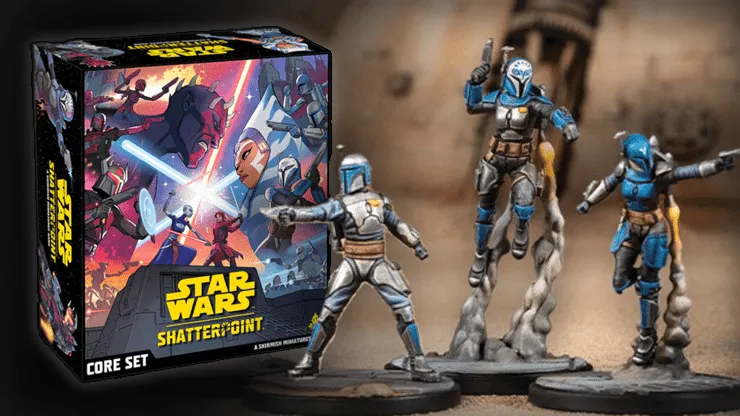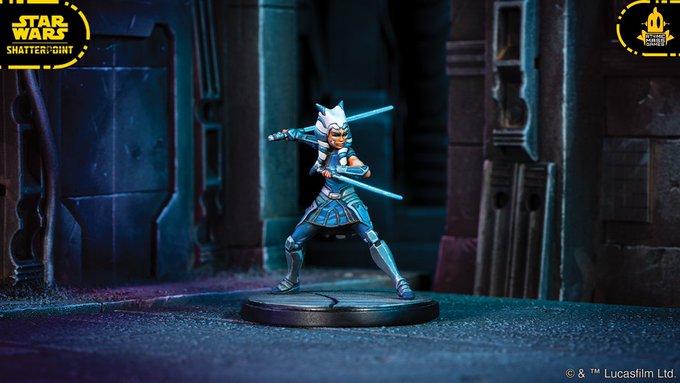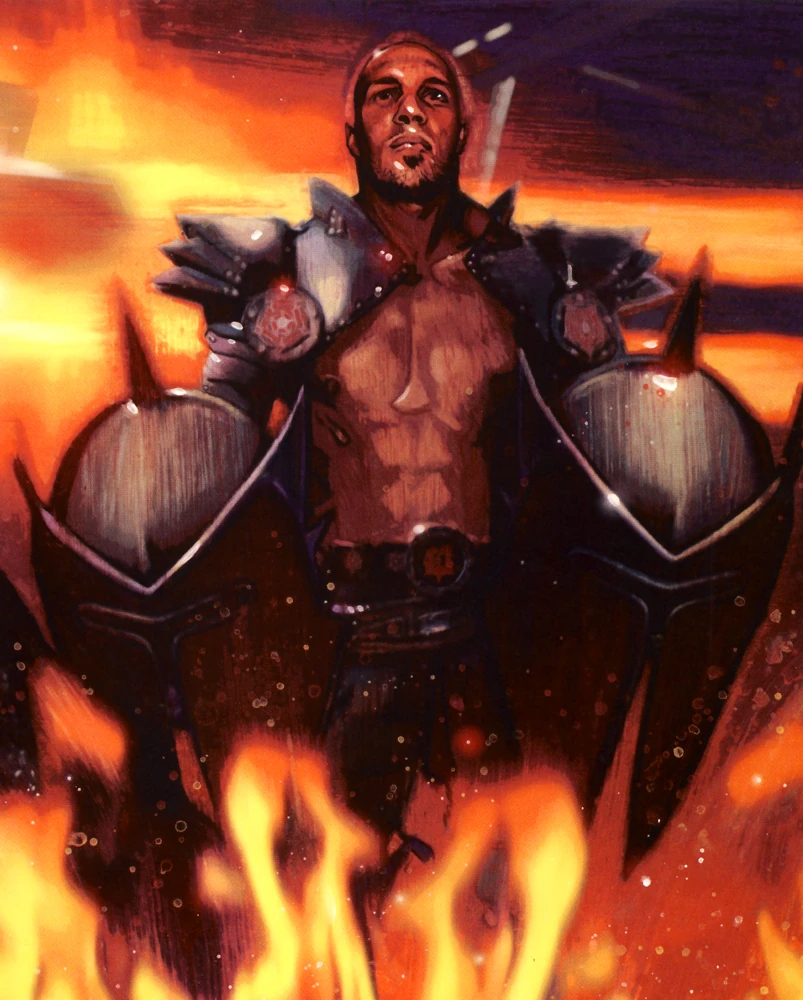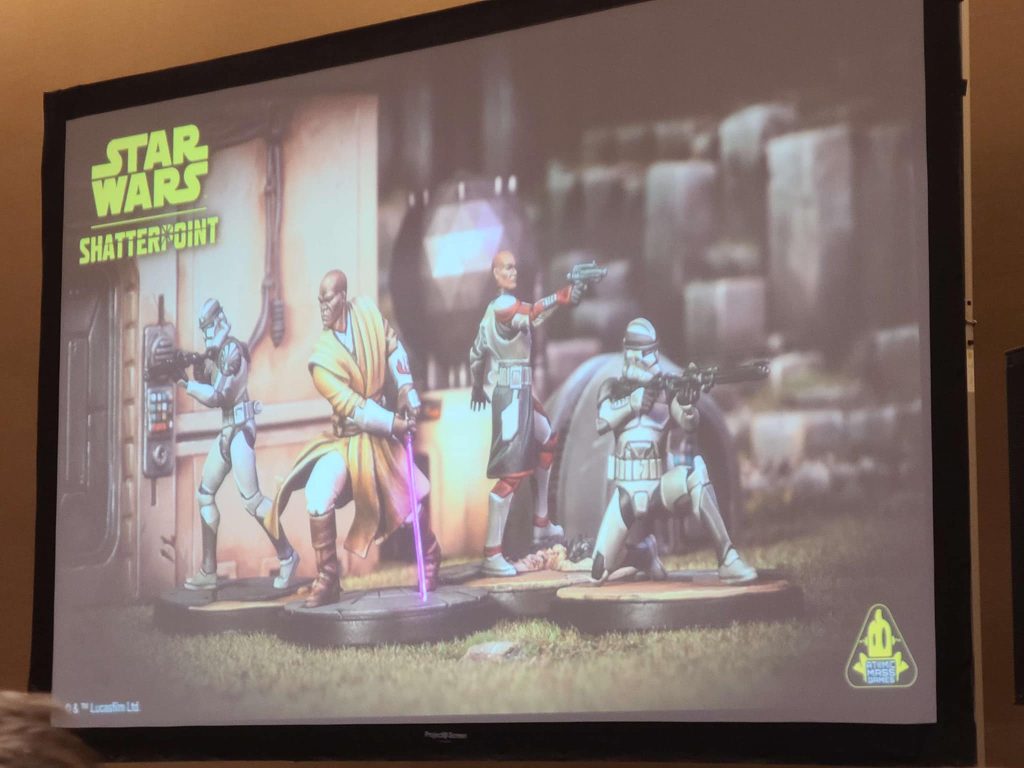
Trending Today

EDIT: Now that enough time has passed, we hope you enjoyed this April Fool’s joke, but I don’t want to confuse the ever-living hell out of people when we DO review the full release of Shatterpoint (the game). If you actually want to read a review of Shatterpoint: The Novel, then go right ahead!
The Fifth Trooper is back from Adepticon and we have a special treat: a review of the FULL RELEASE of Star Wars: Shatterpoint!
Hello everyone! I don’t know what to say, but this website seems to be favored by The Force as we’ve been able to obtain a complete copy of Star Wars: Shatterpoint and have spent hours and hours consuming it, analyzing it, and now, fully reviewing it for you, the people. Let’s waste no time and dig in!

Pictured: Two miniatures of Anakin and Ahsoka from Star Wars: Shatterpoint. Unfortunately, neither appear in Star Wars: Shatterpoint
I was pleasantly surprised that the first thing I saw when I opened up Shatterpoint was a forward written by none other than…George Lucas? In it, he does some basic set up for the Clone Wars era, which is nice even if it’s a bit redundant for those of us who are “initiated.” There are some tantalizing narrative elements of this “Intro” that focus on Yoda and Palpatine even, who we hadn’t seen on promotional material, so it was a pleasant surprise. This section also establishes that “Shatterpoint” takes place 6 months after Attack of the Clones, so there’s no General Grievous action to be had yet.
But let’s be honest here, this is all about Mace.
Before we really get going I want to give some forewarning: this is a review of Star Wars: Shatterpoint, which means that the topics of war crimes, bigotry, and the conflict in Afghanistan are pretty much unavoidable. One thing that we should all keep in mind is that Shatterpoint was released in 2003. That was a very different time, both for Star Wars and the real world.
Also, there will be a few spoilers in here, but hopefully folks don’t mind since this is Legends material anyway.
The overall plot beat is that Mace Windu’s former apprentice, now Jedi Master Depa Billaba, has been entrenched with a pro-Republic guerilla operation in a relative backwater (Haruun Kal) of the Clone Wars for months. Some holo-footage is found that suggests she may be up to some EXTREMELY no-good things, and also contains fairly crazed message from her directly to Mace… found sewn inside of a person’s mouth. Again folks, this is not a rated-PG Star Wars novel.

Pictured: Some lovely Mandalorian models, which do not appear anywhere in Star Wars: Shatterpoint
Mace decides to go alone to check things out, though there are some Republic contacts there who can hook him into the friendly guerrilla operation. But here’s a curveball for you: this is the planet where Mace was born! It’s a world where the only habitable terrain is at the very top of a few mountain peaks, and all the indigenous human population (the Korunnai) is very force sensitive. It’s even suggested that this human population are descendants from a Jedi scouting project that got stranded thousands of years ago, who understandably decided to toss out the whole “no relationships thing” when Coruscant left them them for dead and stopped looking.
If this all sounds familiar, then it’s possible that you had a high school English teacher who was brave enough to assign Joseph Conrad’s Heart of Darkness, or perhaps you’ve seen Coppola’s classic Apocalypse Now. To simply say this novel is “Star Wars: Heart of Darkness” however gives both too-much and, strangely, not-enough credit to the book. I’ll get into that a bit more later.
Shatterpoint is mostly unique among Star Wars novels in that is has…some ideas and is something more than a series of plot points. The planet, for instance, is run by outsider “corpos” who are allied with the Separatists and the Korunnai population that Mace was plucked from as a child (by Yoda) has now found themselves officially restricted to its single urban center against their wishes. This creates an “excuse” for corporate prospectors to basically shoot them on sight outside the city, and now constant guerilla warfare plagues the countryside of a world that is already extremely hostile between its large predators and bounty of diseases from brain eating wasps to a fungus that quickly renders electronics useless. This latter point means that there are basically no droids on-world (which would have sapped the dramatic tension anyway) and the most reliable weapons are “slug throwers” aka just regular old guns.

Pictured: A model of Ahsoka Tano, who does not appear in Star Wars: Shatterpoint
Harun Kal thus evokes a colonizer vs indigenous dynamic that is quite familiar to us in general, but is perhaps most analogous to countries in which proxy wars were fought between the US and the USSR. One of the chief appeals of the planet are in fact its native plants that can be harvested to create both medications and mind-altering substances. When you combined the facts above with the timing (2002) I think it’s clear as day that the novel abounds with allegory for the very real and very awful crimes against humanity suffered by the Afghan people from the 1970’s through the 2001 invasion by the United States and basically straight on through to today.
If you are already surprised by the content of this book, then let me tell you, it gets even more intense than what I am describing. It pulls very few punches when it comes to the reality of guerrilla warfare, both from a sociological and a body horror point of view. If you were a parent absent-mindedly buying a neat looking Star Wars book for your 10 year old around 20 years ago, you would have been making a bit of a mistake. I read an interview with the author, Matthew Stover (who also wrote the novelization of Episode 3) and he stated that part of the reason his books are so violent is because he wants to acknowledge that mankind grotesquely appreciates its entertainment value, and wants to provoke thought (and perhaps guilt) by highlighting that violence “is the kind of fun you can’t get anywhere else.”
The descriptions of scenes, however grotesque, is honestly one of the novel’s main strengths. This is not only because they are vivid, but the world-building itself is clever and intriguing. The concept that outworlders would need to bathe themselves in probiotic gel as well as encasing sensitive electronics in anti-microbial sci-fi surgical fields, both of which protect against rampaging local fungus, adds a Star Wars-y bent to familiar concept of the “disease-ridden jungle.” The story’s primary antagonist, who is teased at but not totally confirmed as being a younger cousin or even possibly a brother of Windu himself, uses the Force in a way that is unique from traditional Jedi or Sith or even Dathomiri cultures we have seen before. It is a very pragmatic use of the Force that is centered around one thing: kicking ass in the jungle while wielding two giant reflective axe-bracer-shield…things.

Image of Kar Vastor, who is probably Mace’s brother, but who is not named WIndu. Taken from “Star Wars: The New Essential Chronology” which is ironically now an old disposable chronology since it was released in 2005
Indeed, Windu’s pragmatism is and always has been my favorite aspect of his character. Throughout the book he does a whole lot that we wouldn’t really consider “typical” Jedi behavior. He threatens, he intimidates, he questions the manhood of thugs, and he spends little time buried in philosophy. “I don’t have to explain reality” he states in the novel’s first third, “I just have to deal with it.” Indeed, these tactics are not performed because of flaws in his character, but rather that they are the best way to achieve the end of justice and the protection of innocents. A little intimidation can prevent a fight from happening at all, which is far more effective at preserving life than a fight brought on by the stubbornness of a negotiator to adapt to a changing situation. There are a few moments of high intensity in the book, where Mace finds himself caught between the two sides of this ugly conflict and Stover explores the high-stress, constant calculations that he has to do in order to find the middle-ground of action that saves the most lives. Sometimes this involves a little Force persuasion, sometimes it involves holding crying children hostage. Mace does not allow his ego to get in the way of what needs to be done.
Well, he usually doesn’t anyway. One concept introduced early on in the novel is that when he got the drop on Dooku and Jango on Geonosis, he feels extremely sure that he could have stopped the Clone Wars early by sacrificing himself to take Dooku down with him. This ties into the title of the novel, Windu’s unique ability to see “Shatterpoints” in the universe both in the physical sense and the “chain of events” sense. This might mean that he can literally see the weak point in a boulder where one blaster shot will cause it to crumble, or it might mean that he can see the full downstream impact of a particular course of action. The novel uses this force power with discipline, it’s neat when it comes up but it is not a crutch by any means.

The moment Mace regrets constantly
The first half of the novel is mostly build-up and tension. As the plot develops, Mace is consumed by the anger and suffering he is constantly surrounded by (made worse by the Korunnai’s attunement to the Force), which tugs at one of his character flaws: he likes fighting. He won’t go out of his was to stir thing up, but he kind of “hopes” that an opponent will choose to fire a blaster instead of dropping it in surrender. If he feels like he is descending into brutal instincts just a few days in to living on this planet, he wonders, what must Depa be going through after spending a month there?
The book is not without its faults. The dialogue is generally great (“when the big dog is walking, little dogs step aside”) but sometimes Mace Windu’s inner monologue can be a little cringe. There is a mention of a dejarik move called a “fork” where you basically force an opponent to choose whether one piece or another dies, which leads to the line “we are well and truly forked.” Oof. There is also generally a bit of a predilection towards action movie one liners, which can be cheesily great but don’t exactly mesh into the fiction extremely well:
"You are better prepared than most." Mace balanced his lightsaber on his palm. "But like all those others, you've forgotten the only piece of equipment that would actually do you any good." "Yeah? What's that?" "An ambulance."
Depa herself also leaves a bit to be desired as a character, I was expecting her to be in full Sith mode by the time Mace finally finds her but the reality is less impressive and I generally don’t think she is given enough agency or motivation as a character. Worst of all is how her story ends, becoming about the most literal “Fridged” woman in fiction in my recent memory. Yep, it was 2003 for sure! Things aren’t perfect these days for women written by men we’re at least doing better, exemplified literally by the fact that in her new canon death Depa saves the life of her apprentice Kanan Jarrus who ends up being a big part of the Rebellion’s success later on.
The most jarring part of the novel however is its dual nature. The first two thirds is a tense descent into the madness of a jungle, and the last third is a raucous Star Wars mega battle. Both largely succeed in what they are trying to do, but the massive shift in tone gave me some severe whiplash. I will say that each has its own excellent moments, including a standoff between Mace and three gunships that are basically attack choppers, as well as a protracted “Shatterpoint” sequence during the finale that is basically an extremely fun and violent Rube Goldberg machine of violence. This sometimes stretches belief however (yes I know it’s Star Wars, be quiet) since Mace Windu often keeps his own allies in the dark about what “the plan is” so that we can be surprised. Imagine the “reveal” scene of Ocean’s 11 but Clooney was the only person who know everything that was going on, that’s the end of this novel in a nutshell.

Though he is the star in Star: Wars Shatterpoint, Mace Windu will not be a part of the initial release of Star Wars: Shatterpoint
So would I (and therefore The Fifth Trooper) recommend Star Wars: Shatterpoint? Absolutely, I think that as far as Star Wars novels go it takes more risks than most do and it’s fun to get in the mind of a character who we knew was absolutely cool from the start thanks to his performance by the venerable Samuel L. Jackson from the first moment we saw him. Let us know what you thought of the novel in the comments, and be sure to tune in to this website in the coming weeks where we’ll get into our first impressions of Star Wars: Shatterpoint after our demo at Adepticon last week.
Copyright © 2024 The Fifth Trooper. All Rights Reserved.
2 Responses
Oh yeah, I loved this novel! My mom definitely wouldn’t have approved if she knew it’s contents, lol. This was my favorite April fools joke this year <3
Thank you Dominique!